The nation’s online population has grown steadily over the past four years, as has the percentage of the public that regularly gets news from the Internet. Two-thirds of Americans (66%) say they go online to access the Internet or to send and receive email, up from 54% in 2000. During the same period, the number of people who go online for news at least three days a week has grown from 23% in 2000 to 29% today.
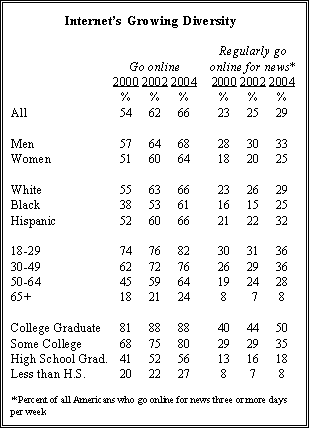
As in previous surveys, Americans who go online tend to be young and well-educated. Yet there also are signs that the online population is becoming more diverse. Racial disparities in Internet use have narrowed considerably over the past four years. In 2000, 55% of whites went online compared with just 38% of African Americans. Two years later, the gap narrowed to 10 points, and stands at just five points today: 66% of whites and 61% of blacks say they go online.
Yet sizable age and education differences in Internet use persist. Increasing numbers of young and even middle-aged Americans are going online a solid majority (64%) of Americans age 50-64 now are logging onto the Internet, up from 45% four years ago. But senior citizens have been slower to adapt; only about quarter (24%) go online, up modestly from 2000 (18%).
And while many more high school graduates are going on the Internet than did so four years ago, growth has been much slower among those who have not completed high school. Just 27% of this group goes online, compared with 20% in 2000. Roughly twice as many high school graduates as those without high school diplomas go online (56% vs. 27%), and Internet use is even higher among those who have attended some college (80%) or who are college graduates (88%).
Minorities Log On For News
As the overall base of Internet users has broadened, so has the population that regularly uses the Internet as a source of news. Over the past two years, especially, racial and ethnic differences in online news consumption have lessened. Two years ago, 26% of whites and 15% of African Americans went online for news at least three days a week; today, the gap is just four percentage points (29% white/25% black).
Nearly a third of Hispanics (32%) go online for news at least three days a week, which is a slightly higher percentage than Americans generally (29%). This represents a ten-point increase from 22% two years ago.
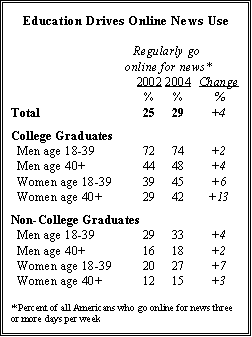
Yet education continues to be the biggest single factor driving online news use, largely due to the continuing gap in Internet access. Fully half of college graduates regularly use the web for news, compared with just 18% of high school graduates and 8% of those who didn’t finish high school. When education and age are analyzed together, striking patterns emerge; about three-quarters of male college graduates under age 40 (74%) regularly go online for news, compared with just 45% of female college graduates in the same age category. That dwarfs the overall eight-point gender gap in regular Internet news use (33% vs. 25%).
In addition, many more younger male college graduates (those 18-39) than those age 40 and older regularly go online for news (74% vs. 48%). There is no such age difference among women college graduates because of a rapid growth in online news use among female college graduates age 40 and older 42% regularly log on for news, compared with 29% two years ago.
There has been little growth in Internet news use among the people with less than a college degree, regardless of age or gender. Among the younger age group (18-39), similar percentages of non-college men (33%) and women (27%) go online for news at least three days a week. Both men and women over age 40 without a degree are the least likely to go online for news with any regularity (18% men, 15% women). These numbers have increased only slightly in the past two years.
Online News and Daily Life
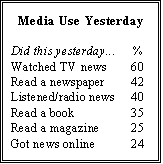
Despite the growth of the Internet news audience, going online for the news has yet to become part of the daily routine for most Americans, in the same way as watching TV news, reading the newspaper or listening to radio news.
Asked about their news use on a typical day (“yesterday”), just under a quarter of Americans (24%) say they went online for the news. That compares with 60% who watched TV news on the previous day; 42% who say they read a newspaper; and 40% who listened to news on the radio. About the same number of people say the read a magazine the previous day (25%) as went online for news.
In addition, people spend far less time in getting the news online on a typical day than they do getting news from traditional sources. About half of Americans (51%) say they spent at least a half-hour watching TV news the previous day; roughly a quarter say they spent at least a half-hour reading the newspaper (26%) and listening to radio news (25%). Just 7% say they spent that much time getting the news online.
In part, these differences reflect the unique role the Internet plays in daily life. While television and radio are sources of entertainment as well as news, the Internet also serves as a means of communication, a research tool and a virtual shopping center. Nearly as many Americans watched a news program on TV yesterday (60%) as watched any other kinds of non-news programming (63%). But when it comes to the Internet, fully 47% say they went online the previous day, but only half as many (24%) got news when they were there. More people say they emailed a friend or relative the previous day (28%) than went online for news.
Inadvertent News Consumers
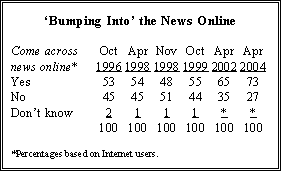
It has become increasingly common for Internet users to come across news inadvertently while online for other purposes. Fully 73% of Internet users come across the news this way, up from 65% two years ago, and 55% as recently as 1999.
More than eight-in-ten Internet users under age 30 (82%) say they inadvertently come across news online, but this practice also is common among older people who go online. The only age group where it is not widespread is among the relatively small segment of people age 65 and older who go online.
While large majorities in nearly all demographic groups report coming across news on the Internet when not looking for it, there are some differences by race and ethnicity in how frequently this occurs. African Americans (83%) and Hispanics (79%) are more likely than whites (70%) to accidentally get news online when logging on for other purposes.
Search Engines and the News
The Internet provides news to people not actively seeking it, but it also enables those who are interested in a particular topic to research it more deeply. Seven-in-ten of those who go online for news (41% of Americans overall) say they have used search engines like Google or Yahoo to get information on news subjects in which they are interested. Roughly a third of the online news audience (34%) uses a search engine at least weekly.
As might be expected, regular Internet news consumers employ these search engines most frequently. Nearly half of those who go online for news regularly three days a week or more (47%) use Google, Yahoo or a similar search engine at least weekly. And 12% of regular online news consumers (at least three days a week) do this every day.
A sizable minority of Internet news consumers (26%) also get news via email updates or directly to their computer screens. This percentage rises to 35% among those who go online for news at least three days a week.
Internet News Use and Other Media
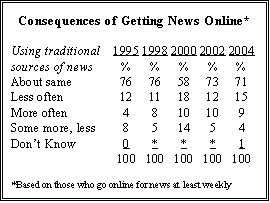
Most who go online at least weekly for the news (71%) say their use of other news sources has not been affected by the Internet. The percentage who say they use other news sources less often (15%) also has stayed fairly stable in recent years, as has the number who say their consumption of news from other sources has increased as a result of getting news online (9%).
Of those who say the Internet has reduced their consumption of news from other media sources, nearly half (47%) say they are using television less often and 39% are reading the paper less often. In terms of actual behavior, however, the Internet appears to have a significantly greater impact on online users’ TV news time than on time spent on news from other sources. Only about a quarter of Internet users (27%) say they spent an hour or more watching TV news on a typical day, compared with 41% of those who do not go online. Both groups are equally likely to have read a newspaper the previous day.
Online News Interests

Weather is the number one news interest of the online news audience, but interest in politics and international news is on the increase. About three-quarters (76%) of all of those who ever go online for news say they sometimes get weather information. That is up from 70% two years ago and 66% in 2000. This represents 44% of all Americans who sometimes get weather information online, up from 32% four years ago.
Over the last four years, there also has been a sharp increase in the percentage who log on for political news (up 15 points since 2000) and international news (up nine points). For the most part, these gains have occurred across political and demographic groups. But as is the case with overall public interest in politics and international news, there are major differences based on education, gender, income and other factors.
Nearly two-thirds of college graduates who go online for news say they sometimes get political or international news (65% each) compared with only about four-in-ten with a high school education (42% each). In addition, more men than women also go online for political and international news. And beyond those two topics, men have higher levels of interest than women in going online for sports news and business news. A greater percentage of women than men go online for local news and women are just as likely as men to use the web for weather, science and health and entertainment news.
Public’s Strong Appetite for Technology
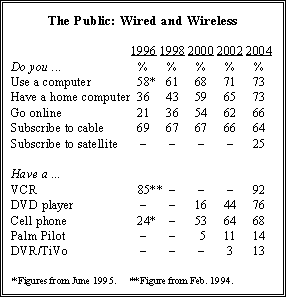
Americans continue to avail themselves of a wide array of technology for business, communication and entertainment. And with increasing speed, some high-tech products particularly home entertainment items are becoming commonplace. As recently as four years ago, just 16% of Americans said they had a digital video disc (DVD) player. That percentage nearly tripled by 2002 (to 44%), and has again increased sharply (to 76%).
The use of digital video recorders, TiVo being the most commonly known brand, has expanded quickly from a fraction of the population two years ago (3%) to 13% today. Growth has been slower in older home technology items, like video cassette recorders, which remain practically ubiquitous (92%).
The number of Americans who subscribe to cable TV has slipped a bit over the past decade, due at least in part to the prevalence of satellite TV as an option. Currently, 64% nationwide say they subscribe to cable, and 25% subscribe to a satellite TV network such as the Dish or DirectTV. Satellite service has been adopted by nearly half (47%) of those living in rural parts of the country, where just 38% have cable (down from 47% two years ago). But cable still has three to four times as many subscribers than satellite in cities and suburban areas.
Digital communication tools such as cell phones and Palm Pilots continue to expand in popularity. Over two-thirds (68%) report owning a cell phone, up only slightly from two years ago (64%). A much smaller proportion of Americans (14%) own a Palm Pilot or other similar product.
Cell Phone Use Growing Among Seniors

The growth of cell phone use since the mid-1990s shows how different age groups adapt to new technologies. Over the past nine years, cell phone ownership has increased dramatically across all age groups, though older Americans have been slower to adapt.
But in recent years, as cell phone use has become widespread among younger people, overall growth has slowed. By contrast, the growth in cell phone use among those in their 60s and especially those in their 70s has been robust. Today, half of those age 70-79 say they have cell phones, compared with just 38% two years ago. That is the largest increase for any age group over that period.




